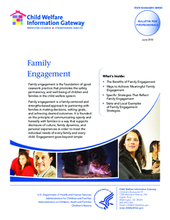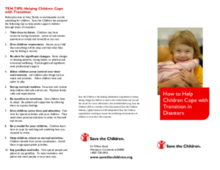Displaying 2071 - 2080 of 2144
Family engagement is the foundation of good casework practice that promotes the safety, permanency, and well-being of children and families in the US child welfare system. This brief offers information to help State child welfare managers improve family engagement across program areas.
A leaflet for parents on how to help your child cope during an evacuation or relocation in an emergency.
An overview of considered best practices in therapy for child survivors of physical and sexual abuse.
A new Child Trends fact sheet examines the role that programs for older youth can play in promoting positive development and subsequent self-sufficiency in adulthood.
This new report from the Annie E. Casey Foundation outlines initiatives in four sites to help child welfare systems reduce institutional placements, improve outcomes, and support community services by changing the array of services, frontline practice, finances, performance management, and policy
Statement noting potential dangers associated with ICA in emergencies with specific reference to risk of family separation.
Online update on concerns around promoting adoption in an emergency context.
"The desire of the Haitian people, to the extent that this can be done, is for the children to be cared for in Haiti…That is their preference"
This article describes several parent partner/advocate programs operating around the United States, including programs that train parents to serve as parent mentors and programs that train parent leaders to sit at the decision-making table and influence child welfare policy.
This in-depth working paper explains how genes and the environment interact, and gives recommendations for ways that caregivers and policymakers can effectively respond to the science.








